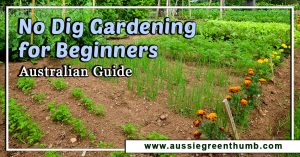Water gardens don’t need to be a scary prospect, but if you want to go all out, you can be truly ambitious in your designs, and create whole new worlds for wildlife, and relaxation. If your space is limited, you can build a water garden in nothing more than an old sink bowl.
Whatever your aim is, our guide will lead you through how to build water gardens for any aspect, and any outcome, be it a small bowl of moving water, or a still wildlife pond.
As well as exploring how to build your first water garden, we’ll look at how to choose the right plants and some of the incredible benefits to mental health you can get from adding water to your outside space.
More...
What is a Water Garden?
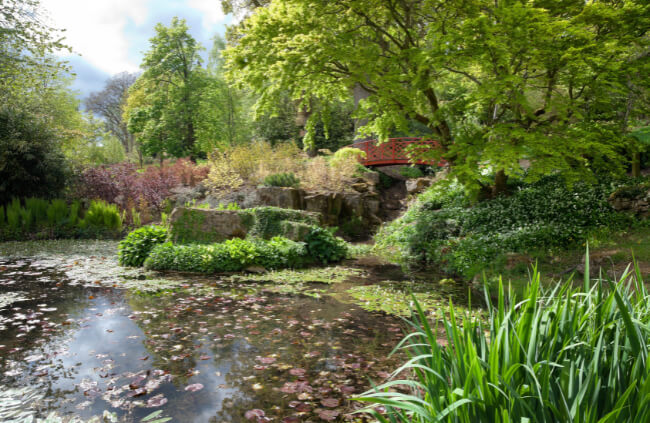
Water gardening is a very general term for any form of water, in any size of garden. The smallest water gardens can be old sinks, barrels, or containers, lined and filled with water and pond plants, adding a serene oasis to balconies or patios.
Larger water gardens can really push the boat out though, with ponds stretching from fence to fence, with running water and islands for planting or pathways built through the water. Regardless of the scope of your project though, the outcomes for you and for wildlife will be pretty similar.
In essence, to build a water garden, all you need is a plot, some pond liner, and a few oxygenating plants. The rest is just icing on the cake.
Reasons to Build a Water Garden
If you still need convincing, here are a few indisputable reasons to add water to your garden:
Wildlife
Adding any size of pond or pool to your garden will bring wildlife in. Even a standing bird bath will encourage feeding native birds into your garden, which will not only help to control pests, but add the calming nature of birdsong.
Still ponds, or gently moving streams, particularly with still channels, will encourage amphibious life, dragonflies, and damselflies too. These look beautiful, and most amphibians help to control slugs too!
Peace, and mood setting
Water is tranquil. Even if you’re scared of water, or don't like swimming, adding a small pool can be a safe alternative. Adding the sound of running water with a solar fountain helps to dampen the noises of the outside world too, particularly with trickling water near garden boundaries, which can disguise the glaring noise from the busiest roads.
The Challenge
As well as helping wildlife, creating a sense of calm, overcoming challenges, and finishing big projects is a great way to feel connected to your garden, and gain a sense of achievement.
Building a pond, no matter how big, is a surmountable task that anyone can achieve. But the bigger you go, the more rewarding it will be.
Exploring new and exciting ways of planting
Ponds, moving water, streams and fountains all offer a new and exciting space to plant. Pond and aquatic plants open up a whole new world of horticulture, allowing you to experiment with ornamental lotus blossoms, water lilies, and marginal plants like irises and rush.
Pond plants don't just look good though, they offer sanctuary and food for pollinators, birds, and small mammals too, making your garden a safe space for you, and your garden visitors.
Keeping fish
One thing I’ve never gotten round to, but am planning on this year, is a fish pond. Whether it's impressive fish like coy or simple native species, fish provide the sound of trickling, rippling water, without any need for fountains.
You can often manage fish ponds naturally with oxygenating and water-cleaning plans, but there are also options to explore with filtration pumps and air filters for ponds, which help to maintain a healthy space for any fish.
Different Types of Water Garden
Water gardens really do come in all shapes and sizes. Personally, I don't think you can beat a natural pond, packed with plants and wildlife, but I’m also a sucker for running water, and love the idea of adding fish to my outside space for the simple joy and relaxation that watching them brings.

Fish ponds
Fish ponds are perhaps the most popular way to add water to your garden, and can be sunken into the ground, or raised up in concrete or brick-built pools. They require some form of filtration, whether it is electrical or natural, and regular cleaning and maintenance.
Their biggest benefits are simple; you get to sit, watch, and feed your fish, which, if nothing else, forces you to take a break from busy day-to-day living and spend time outdoors.
Natural ponds
Natural ponds are easy to achieve, either by lining a hole in the earth with clay or (more reliably) using a protective fabric beneath the pond liner for an instant pond.
It's important to add layers and steps to any natural pond, so you can explore different depths of planting, and so that wildlife and pets can escape if they fall in, so the whole process becomes an experiment and exploration in water garden design that anyone can undertake with beautiful results.
Running Water Gardens
Running water is a more ambitious step to take with any water garden, but can be as simple as installing a water fountain in an existing pond. For more impact though, consider adding a rockery or waterfall to the edge of a pond, so that water can run and trickly down the rocks, adding bubbling sounds to the garden.
Modern and contemporary water gardens often use pre-built water features too, with no limit to the creativity that goes into fountain design. Reflective, rust-resistant metals make a beautiful backing to screens of running water, which add a gentle sound, but also help to reflect sparkling light back around the garden too.
Container ponds
Container ponds are a must on any patio, and really aren’t hard to produce. If you’ve got a few seasonal plants in pots around the house, or on the balcony, just think how much they'd be improved by dazzling displays of 1.5m, tall, bright yellow irises, soaring out of a container of still water.
Within weeks, even on the highest balcony, there’ll be water insects who have miraculously found their way into your garden too.
Swimming ponds
Perhaps the most ambitious modern water garden feature is a swimming pond. We’ve all heard of swimming pools, and they are incredibly popular and useful additions to most gardens, but for something a little bit different, you can dig out huge patches of earth (the same size as a swimming pool), leaving steps around the edge.
Once the whole thing is lined with pond liner, you can start to add layers of planting, from deep-down water lilies and oxygenators, to margin irises and rush. Once filled, you’ve got a natural pond, that in time will be a self-sustaining, self-cleaning organism that's clean enough to swim in.
Until recently I hadn't experienced one in person, but a friend installed one last year and invited me over early this summer for a swim. The experience was like nothing else and offered a true feeling of being in nature, with full immersion into a water garden like nothing I’d come across before.
How to Build a Water Garden
Building your own water garden needn’t be a chore. For some styles, there is more building work required, but the guide below shares the basics of building your first pond, which can be adapted to suit fish ponds, swimming ponds, or simple water features, provided pumps are dug with the appropriate reservoirs for stand-alone features.
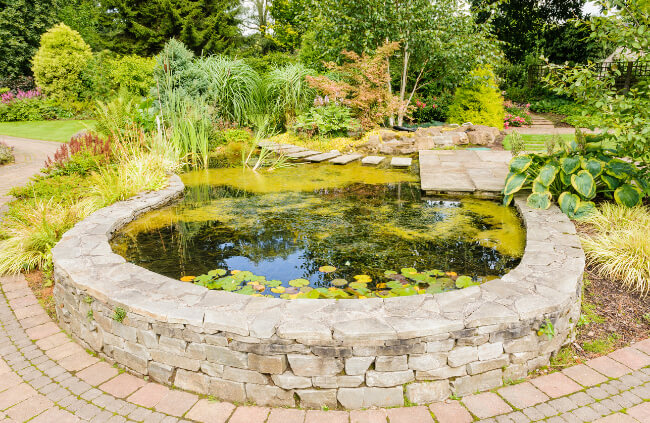
The Basics of Builing a Water Garden
Getting started with a water garden means investing in a few bits and pieces. Most importantly, the lining. Pond lining is a sturdy, and generally flexible polyethylene fabric, sold in large sheets, or even on rolls like carpet.
That’s the most basic version of pond lining you can use, but for a more precise finish you can build it with breezeblocks and render in a waterproof material or tile like a swimming pool.
Tools and Equipment
To build a basic pond, you’ll need your waterproof lining, some protective material to lay down beneath it (this just helps to prevent rocks or sharp objects from piercing the lining while the water’s weight presses it into cracks and crevices), and some oxygenating plants.
- Lining
- Fleece or protective layers
- Oxygenating plants, or water pumps (See our in-depth guide to different types of water pumps and how to choose the best for your needs).
After that, it’s just a case of digging and shaping to your heart’s desire.
Water Garden Structures
Regardless of the pond you’re building, it's always worth digging down slightly to get better pressure for the foundations and for the weight of the water, which naturally wants to travel outwards.
Building a Natural Water Garden
Natural, sunken ponds are simple to build, just dig out a layered hole, with steps at 10cm deep, 30cm deep, and then graded into the centre. The central section of a pond should be at least 2 ft deep, but more is better, particularly if you eventually want to add fish, which need at least 1 metre from the surface to protect them from summer sun.
Building a Raised Water Garden
Raised water gardens can be built on concrete, with breeze blocks or even timber structures, but they need to be absolutely sturdy because the weight of the water doesn’t simply push down, it pushes out too.
If you can, dig down 1 ft into the ground to foundation blocks, before building the above-ground section. Fill the base in with compacted gravel, grit, or any appropriate substrate, and line the whole thing with a pond liner, sealing it with a neat rim of stone or tile so you can't see the liner when it's filled.
Then fill the pond. The outside face can be rendered or painted, and the inside can have filter pumps added, and be as large or small as you like. The bigger the better where fish are concerned.
Installing Water Features
Water features often don't need a pond at all. Some come with tanks that need to be sunken into the ground, and then covered with a layer of pebbles or decorative stone to hide them.
Above ground, all you’ll see is the fountain section, or waterfall, offering a way to add water to your garden without having to worry about cleaning leaves or debris from the tank.
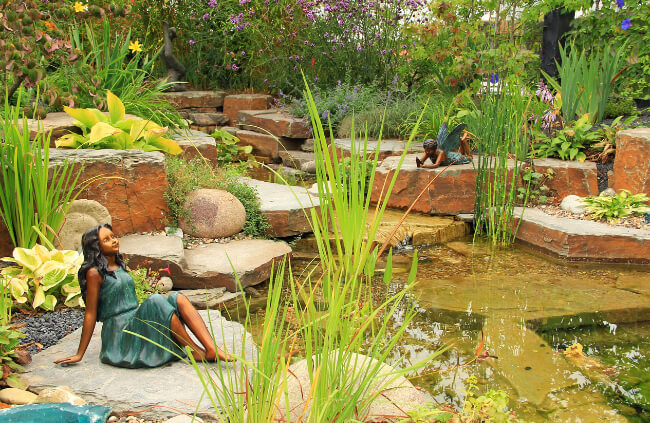
Choosing Water Garden Plants
Ponds need a mix of oxygenating and ornamental plants. This allows wildlife to crawl in and out of the pond, as well as offering habitat around the roots. The oxygenating plants filter and clean the pond, as they reduce blanket weed and algae too.
The easiest oxygenating plant to grow, which is fairly easy to control, is Hornwort, but for more inspiration check out our guide to the best pond plants to grow in Australia.
Water Garden Animals
Once your pond is ready, there’s not much you need to do other than wait. Animals, amphibians, and birds will quickly find any water in your garden and make it their home, helping to maintain a healthy ecological balance.
Don’t be tempted to add frog or toad spawn to your pond from other gardens or wild ponds as it can bring in disease. Instead, allow local wildlife to filter in on its own time.
Introducing fish
If you prefer to have more control over your pond’s natural inhabitants, there are several omnivorous fish species, like Pleco or Catfish, which will eat insect larvae and tadpoles, making sure the pond is clean and kept solely for them.
Remember that fish are sensitive to change, so introduce them slowly by adding small amounts of pond water to their water over a period of hours or days so they can slowly get used to their new conditions before being submerged in a new home.
Common Problems to Avoid with Water Gardens
While water gardens will usually look after themselves, there are some problems that can occur, particularly with still water like ponds or container ponds.
Water Garden Pests
Mosquitoes and flying insects often lay their larvae in still water, and when they hatch you’ll have a serious infestation on your hands. Keeping fish, or encouraging frogs and toads into your pond will generally stop this from happening as they all feed on mosquito larvae.
Adding rush or irises to the pond margins, or planting into containers or water butts, will encourage damselfly and dragonflies to lay eggs too, which will help control mosquitoes even in the smallest of ponds.
Water Garden Safety
If you have young children or pets, consider creating a raised water garden, or covering your pond with a sturdy mesh for a few years. Make sure the mesh has 5 cm holes as a minimum so wildlife can access water to drink, but small feet can’t fall through.
How to Maintain a Water Garden
Like any part of the garden, water gardens come with some ongoing maintenance, but are generally easier to keep tidy than lawns or flower beds.
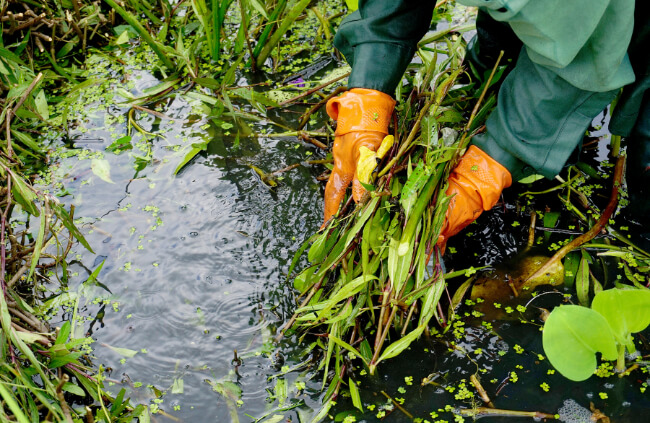
Cleaning Debris and Fallen Leaves
Fallen leaves will collect in your pond, even if you don't have directly overhanging trees. Once a year, scoop down into the base of the pond with a fishing net or your hands and pull out any debris at the base.
Leave the wet leaves and debris by the side of the pond for 24 hours so any pond life can crawl back into the pond before you remove it and add it to the compost.
Keeping the Water Clean
The easiest way, and cheapest way, to keep your water garden clean is to use oxygenating plants that control the spread of problem plants, and maintain healthy conditions, but you can also use pond pumps and pond filters to do the same job if you want to keep a crystal clear water garden, without adding plants.
Feeding Fish Properly
Every species of fish needs a different feeding routine. Overfeeding will quickly lead to a build-up of bacteria, as fish stop eating when they’re not hungry and left overs simply sink to the bottom and rot.
Keep track of your fish, and feed them appropriately.
Dividing Marginal Plants
Marginal plants like iris and rush are usually clump-forming perennials, often with thick rhizomes. Every two or three years, it's worth lifting them out of the pond and pulling off excess growth. It can be composted, or stored for a few days with a bin liner around its base before giving it to a friend.
If you allow them to spread out, they will stop growing eventually, but you will lose the visible water, so it's best to do a little every few years, than leave it too long.
Dividing Pond Plants
Deep water plants like water lilies might look serene at the surface, but every five years, pull their roots from the base of the pond and cut them right back to the size they were when you bought them.
You can do this by dividing them (just carve through the roots with a knife) or by snapping off unwanted roots. They will recover quickly, and it will stop them from taking over both the top and bottom of the pond.
Water Gardening Frequently Asked Questions

What is the concept of a water garden?
Traditional water gardens were designed with the concept of allowing gardeners to grow plants that were native to lakes and rivers. However, now they are mostly designed with peace and tranquillity in mind, often featuring fish and fountains in place of plants.
How do you make a small water garden?
Add a layer of gravel to the base of a small watertight container, then add a few clean bricks to one side, so they sit about 15 cm below the top. Fill the container with water, then add an oxygenating plant and some marginal plants that can sit on the bricks.
Ideally, this should be about 45-50 cm across, but 30 cm containers will work for very small spaces.
How do I clean a water feature?
Water features can be home to beneficial wildlife, so even with sunken tanks, it's worth cleaning the visible sections with organic cleaners like vinegar. They will affect the water pH, but won’t do too much harm to your garden.
Should I leave my water feature on all the time?
Water features with mains connections are designed to run 24 hours a day, and when they stop running algae can build up on the display section. However, as most water features are sold with solar pumps, they are generally only running for 8 hours a day at full capacity.
Savour the Tranquility a Water Garden Can Bring in home
Water features are the best thing you can possibly add to your garden, even if you aren’t fully sold on the idea of an all-natural water garden just yet. The tranquillity and peace of water in your garden will truly change your life, and at the very least, change how you interact with your outside space for the better. I’m a water garden convert, and I hope you are too.
Published on June 14, 2023 by Gary Clarke
Last Updated on October 25, 2023

